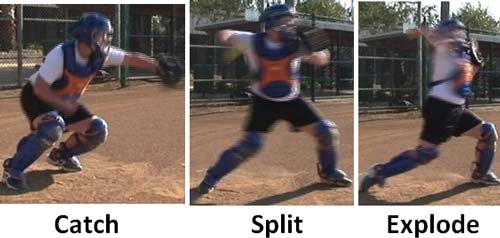
Are you sure what to tell your catchers when it comes to their hand position during throws? Do they bring the ball back to the ear, to their throwing position, or does it matter? Read on to solve this much debated issue.
Teaching catching is something we could all do a better job of. Make sure you know how to properly teach the hand position for your catcher’s when they make their throws down to 2nd base – or any other base for that matter. Quickness matters to catchers and their hand position upon separation is crucial to a quick release.
While pitching and hitting get most of our time and attention, when we find ourselves with runners on base it’s our catchers that we suddenly rely on. Catchers that probably haven’t gotten the detailed instruction those other positions have. So let’s explore more closely just what happens with a catcher’s hand position when she’s making a throw on a steal.
The Key to a catcher’s quick release is to follow this simple 3 step saying:
Catch – Split
– Explode
Catch-Split-Explode
means the catcher must quickly Catch the ball, then just as quickly Split
her Feet and Hands into the throwing position, followed by a quick release
as a result of Exploding her hand and body forward behind the throw. You
can see all 3 positions in the Catch – Split – Explode picture.
You can also see by the blur the forward movement the catcher maintains
in order to fire the ball forward, toward 2nd base. Make sure your catcher
does not stand directly up first before throwing as this will result in
a huge loss of power and speed on her throw.

The next area to look at closely is the catcher’s Split to Explode. In this part of the throw the catcher brings the ball back near her back shoulder as all throws start near the players throwing-side shoulder. (I said near it, I didn’t say exactly at it). Notice in the Split to Explode picture that the catcher has a clock placed over her. This helps players better understand where they should take their hands when they bring the ball back to start the throw. The rule of thumb on this is: the longer the throw the longer you wind the clock. So, an outfielder who has a very long throw will take the ball back low around the 6 o’clock position. An infielder has a shorter throw so she’ll wind her clock around the 9 o’clock position and the catcher, who has the quickest throw to make, will wind her clock around the 10 o’clock position.

You can see a picture of
a catcher’s throw and the clock in the picture of the Correct throwing
position and an Incorrect throwing position. Notice that the Correct picture
has her hand coming immediately to the 10 o’clock position while in the
Incorrect picture she’s bringing the ball down to 7 o’clock – which makes
the throw longer and slower. 
Staying with the Split to Explode picture we can see in the second photo that the catcher has brought the ball back near her back shoulder (the dotted yellow circle). It’s not at her ear but more by her back shoulder since keeping the ball near the back ear tends to cause catcher’s to push the ball when they bring the ball forward in the throw.
The next picture in this Split to Explode sequence shows the catcher starting to bring the ball up to throw it forward, and the yellow line simply shows that the catcher does not let the ball get out beyond her elbow until she has actually started her hand forward as you can see in the final picture.
Also notice how the catcher’s feet have explosively stepped forward and are moving with the catcher’s hand. Too many young catchers simply try to make the throw with their hands and leave their feet out of it. Remember that the speed of the throw lies in the speed of the feet!
Coaches keep in mind that while many of us might tell our catchers to bring the ball back to their back ear (to prevent them from keeping the ball too low) players work hard to do just what we tell them. So a better thing to say might involve the clock so they get a clearer picture of just how high they need to bring the ball and also that the ball won’t be squished up next to their ear but rather spaced between their head and their elbow.
I want to give a little more details to the Pop times I listed in my previous article. These times are game times and include a batter and the catcher staying in her squat prior to receiving the throw and the catcher staying behind the plate (instead of cheating out ahead of the plate):
EXCELLENT = 1.6 seconds
or less (Olympic Level Catchers)
GOOD = 1.8 seconds
(Top College Level catchers)
AVERAGE COLLEGE =
1.9 to 2.1 seconds
AVERAGE HIGH SCHOOL
= 2.3 seconds
I hope this helps clear
up some important issues when it comes to helping our catchers make faster
and more accurate throws.